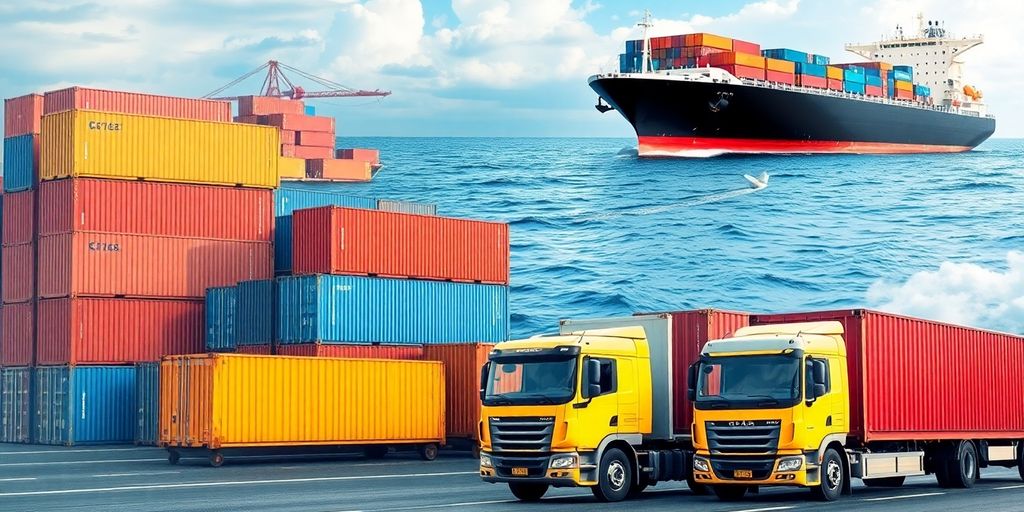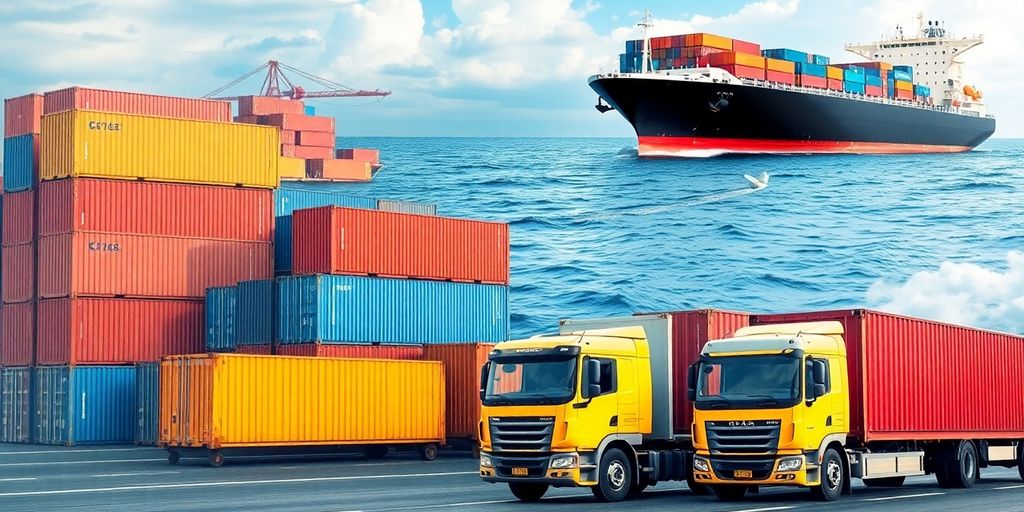Traditional Shipping Alternatives: Finding the Best Rates

When it comes to shipping, many businesses often stick to the big names like UPS and FedEx. But there are plenty of other options out there. In this article, we’ll explore traditional shipping alternatives and how to find the best rates for your needs. Whether you’re shipping locally or internationally, understanding your choices can save you money and improve your delivery services. Let’s dive into the various alternatives available and see what works best for you.
Key Takeaways
- Local carriers can offer better rates and services for regional shipments.
- International shipping can be cost-effective if you know how to navigate customs.
- Hybrid shipping combines different carriers for better pricing and coverage.
- Freight shipping methods vary greatly; choose based on your shipment size and urgency.
- Using technology like shipping calculators can streamline your shipping process and reduce costs.
Exploring Regional Shipping Options
Regional shipping options can be a game-changer, especially if you’re focusing on a specific geographic area. I remember when my friend started her bakery; she initially used national carriers, but the costs were eating into her profits. Once she switched to a regional carrier that specialized in the tri-state area, things improved dramatically.
Benefits of Local Carriers
Local carriers often provide a level of personalized service you just can’t get with larger, national companies. They know the area inside and out, which can translate to faster and more reliable deliveries. Plus, they’re usually more flexible when it comes to accommodating special requests or unusual delivery locations. This can be a huge advantage for businesses that need that extra touch.
- Faster delivery times within the region.
- More competitive pricing for local routes.
- Better customer service due to smaller scale.
When to Choose Regional Services
Regional carriers shine when your customer base is concentrated in a specific area. If you’re a small business primarily serving customers within a few states, using a regional carrier can significantly cut down on shipping costs and delivery times. Also, if you’re shipping items that require special handling or have specific delivery time windows, regional carriers are often more willing to work with you. For example, FedEx One Rate is a good option to consider.
Consider regional carriers if your business model focuses on local or regional sales. They can offer a cost-effective and efficient alternative to national carriers, especially for time-sensitive or specialized deliveries.
Comparing Rates with National Carriers
It’s always a good idea to compare rates between regional and national carriers to see which one offers the best deal for your specific needs. National carriers might seem like the obvious choice, but regional carriers often have lower base rates and fewer surcharges for local deliveries. Here’s a simple comparison table:
| Carrier Type | Base Rate (Local) | Surcharges | Delivery Time (Local) |
|---|---|---|---|
| National Carrier | Higher | More Common | 1-3 Days |
| Regional Carrier | Lower | Fewer | Same Day/Next Day |
Remember to factor in things like fuel surcharges, residential delivery fees, and any other additional costs that might apply. Sometimes, the savings with a regional carrier can be quite substantial. Pitt Ohio is a good example of a regional carrier.
Understanding International Shipping Alternatives
International shipping can feel like a whole different ballgame compared to sending packages across town. It’s not just about distance; you’ve got customs, regulations, and a whole world of carriers to consider. Finding the right approach can save you a ton of money and headaches.
Cost-Effective International Solutions
Let’s be real, international shipping can get expensive fast. But there are ways to keep costs down. One option is to look beyond the big names like FedEx and UPS. Regional carriers sometimes have better rates for specific destinations. For example, FedEx® International Connect Plus might be a good choice for shipping to the UK. Also, consider the size and weight of your package. Smaller, lighter packages are almost always cheaper to ship.
- Consolidate shipments: If you’re sending multiple items to the same address, combine them into one package.
- Negotiate rates: Don’t be afraid to ask carriers for discounts, especially if you ship frequently.
- Compare prices: Use online tools to compare rates from different carriers before you commit.
Navigating Customs and Regulations
Customs can be a real pain point for international shipping. Every country has its own rules and regulations, and if you don’t follow them, your package could get delayed, returned, or even confiscated. Make sure you accurately declare the contents and value of your package on the customs form. You’ll also need to include any necessary permits or licenses.
It’s a good idea to research the customs regulations of the destination country before you ship. Many countries have restrictions on certain items, such as food, alcohol, and tobacco. You can usually find this information on the country’s customs website.
Choosing the Right Carrier for Global Shipping
There are tons of carriers out there that offer international shipping, each with its own strengths and weaknesses. DHL is often mentioned as a more affordable option for international shipping. Consider these factors when making your choice:
- Destination: Some carriers specialize in certain regions or countries.
- Speed: How quickly do you need the package to arrive?
- Cost: What’s your budget?
- Tracking: Do you need detailed tracking information?
It might take some research, but finding the right carrier can make a huge difference in your overall shipping experience.
Utilizing Hybrid Shipping Solutions
Sometimes, sticking to just one shipping method isn’t the smartest move. Hybrid shipping is all about mixing and matching different carriers and services to get the best of all worlds. It’s like choosing the right tool for the job, instead of trying to use a hammer for everything.
Combining Private and Public Carriers
One popular hybrid approach is using private carriers like FedEx or UPS for the bulk of the journey, then handing off the package to the USPS for the final mile. This can be especially useful for reaching rural areas or residential addresses where private carriers charge a premium. Think of it as the private carrier getting it close, and the postal service knowing all the backroads to get it right to the doorstep. It can save money, but it’s important to weigh the pros and cons.
Advantages of Hybrid Models
Why go hybrid? Here are a few good reasons:
- Cost Savings: By using the most efficient carrier for each leg of the journey, you can often reduce overall shipping costs.
- Expanded Reach: Access areas that might be expensive or difficult to reach with a single carrier.
- Flexibility: Adapt to changing shipping needs and customer demands by switching between carriers as needed.
Hybrid shipping models offer a strategic advantage by optimizing cost and delivery times. They allow businesses to tailor their shipping solutions to specific needs, enhancing efficiency and customer satisfaction.
Best Practices for Implementation
Okay, so you’re thinking about going hybrid. Here’s how to do it right:
- Analyze Your Shipping Data: Figure out where you’re shipping to, what it costs, and where you’re seeing delays.
- Choose the Right Partners: Not all carriers are created equal. Find partners that fit your needs and offer good integration.
- Invest in Technology: Use shipping software to manage multiple carriers, track shipments, and automate processes. Without it, you’ll be pulling your hair out.
Evaluating Freight Shipping Methods
Freight shipping opens up a whole new world of possibilities when you’re dealing with larger, heavier, or bulk shipments. It’s not just about slapping a label on a box; it’s about understanding the different methods and how they impact your costs and timelines. Let’s break down some common freight options.
Air Freight vs. Ocean Freight
Air freight is all about speed. If you need something there fast, air is the way to go. Think of it as the express lane for your cargo. Ocean freight, on the other hand, is the slow and steady option. It’s significantly cheaper, especially for large volumes, but be prepared to wait weeks, even months, for your shipment to arrive. The choice really boils down to how quickly you need your goods and how much you’re willing to spend. For affordable shipping, ocean freight is often the better choice.
Consider these points:
- Speed: Air freight is much faster.
- Cost: Ocean freight is significantly cheaper.
- Volume: Ocean freight is better for large volumes.
Consolidated Freight Options
Consolidated freight, also known as less-than-truckload (LTL) shipping, is a great option when you don’t have enough goods to fill an entire truck. Instead of paying for a full truckload, your shipment shares space with other shipments heading in the same direction. This can save you a lot of money, but it also means your shipment might take a little longer to arrive, as the truck makes multiple stops. It’s a balancing act between cost and time.
Cost Considerations for Bulk Shipping
When you’re shipping in bulk, cost becomes a major factor. It’s not just about the per-item shipping rate; you also need to consider things like fuel surcharges, handling fees, and potential storage costs. Negotiating rates with carriers is crucial, and it pays to shop around and compare quotes from different providers. Also, think about how your packaging affects the overall cost. Smaller, more compact packaging can often lead to lower shipping rates.
Bulk shipping can seem daunting, but with careful planning and a good understanding of the different cost factors, you can find ways to save money and streamline your shipping process. Don’t be afraid to ask questions and explore different options to find the best solution for your business.
Leveraging Technology for Shipping Efficiency
In today’s fast-paced world, technology is a game-changer for shipping. It’s not just about getting packages from point A to point B; it’s about doing it faster, cheaper, and with fewer headaches. Let’s explore how technology can seriously boost your shipping game.
Shipping Rate Calculators
Figuring out shipping costs can be a real pain. Luckily, shipping rate calculators are here to help. These tools let you compare rates from different carriers in seconds. Just punch in the details – package weight, dimensions, destination – and boom, you’ve got a list of options. This way, you can easily find the best deal and avoid overpaying. Plus, many calculators include extra fees, so there are no surprises later on.
Automating Shipping Processes
Automation is where it’s at for saving time and reducing errors. Think about it: manually entering addresses, printing labels, and updating tracking info takes forever. With automation, you can streamline these tasks. Here’s how:
- Order Integration: Connect your online store to your shipping platform, so orders automatically import.
- Label Printing: Automatically generate and print shipping labels with the correct addresses and postage.
- Tracking Updates: Automatically send tracking information to customers, so they know when their package will arrive.
Automating these processes not only saves time but also reduces the risk of human error, leading to fewer shipping mistakes and happier customers.
Tracking and Managing Shipments
Real-time tracking is a must-have these days. Customers expect to know where their package is every step of the way. With advanced tracking systems, you can:
- Monitor Shipments: See the current location of all your packages on a single dashboard.
- Get Alerts: Receive notifications about delays or issues, so you can address them quickly.
- Provide Transparency: Give customers access to tracking information, so they can see the status of their order.
Having this level of visibility helps you manage your shipments more effectively and keep your customers in the loop. **This builds trust and reduces the number of
Strategies for Reducing Shipping Costs

Optimizing Packaging Choices
Choosing the right packaging can really cut down on shipping expenses. Using smaller, lighter boxes or poly mailers, when appropriate, can significantly reduce the dimensional weight of your shipments. This is a simple change that can lead to big savings over time. Also, consider using recycled or lightweight packing materials to further minimize weight and cost.
Negotiating with Carriers
Don’t be afraid to talk to different shipping companies. You might be surprised at the deals you can get, especially if you ship a lot. It’s all about asking and seeing what they can do for you. Sometimes, just showing that you’re considering other options can be enough to get a better rate.
Building a good relationship with your carrier representatives can also lead to better service and more personalized solutions. They might be able to offer insights into optimizing your shipping strategy that you wouldn’t find on your own.
Implementing Flat-Rate Shipping
Flat-rate shipping can be a game-changer, especially for domestic deliveries. It’s super predictable, which makes budgeting way easier. Plus, customers love knowing exactly what they’re going to pay for shipping. It can really boost sales and make things simpler for everyone involved.
Here’s a quick look at how flat-rate can help:
- Predictable costs, no surprises.
- Simplified budgeting and pricing.
- Increased customer satisfaction due to transparency.
The Role of Customer Service in Shipping

Importance of Reliable Delivery
In the world of shipping, reliability is more than just a buzzword; it’s the cornerstone of customer satisfaction. Customers expect their packages to arrive on time and in good condition. When deliveries are consistently late or damaged, it erodes trust and can lead to lost business. Think about it – if you order something online, and it shows up a week late and crushed, are you likely to order from that company again? Probably not. Reliable delivery builds confidence and encourages repeat purchases. Businesses that prioritize on-time and safe deliveries are investing in their long-term success. Diversifying your shipping services can help ensure reliability.
Handling Shipping Issues Effectively
No matter how well-planned your shipping process is, issues will inevitably arise. Packages get lost, damaged, or misdirected. How you handle these problems can make or break a customer relationship. Here’s a few things to keep in mind:
- Be proactive: Keep customers informed about any delays or problems as soon as you become aware of them.
- Offer solutions: Don’t just tell them there’s a problem; offer a solution, such as a replacement or a refund.
- Be empathetic: Acknowledge their frustration and show that you understand their concerns.
A well-trained customer service team can turn a negative shipping experience into a positive one by resolving issues quickly and efficiently. This not only retains customers but also builds loyalty.
Building Customer Trust Through Transparency
Transparency in shipping means keeping customers informed every step of the way. Provide clear and accurate tracking information so they can monitor their package’s progress. Be upfront about any potential delays or issues. Don’t hide behind vague language or excuses. Honesty builds trust, and trust leads to customer loyalty. Consider these points:
- Offer real-time tracking updates.
- Provide estimated delivery dates that are realistic.
- Communicate proactively about any delays.
| Aspect | Description |
Wrapping It Up
In the end, finding the right shipping option can feel like a puzzle. There are so many choices out there, and it’s easy to get lost in the details. But remember, it’s all about what works best for you and your customers. Whether you go with a regional carrier, try out USPS, or even look into international options like DHL, the key is to compare rates and services. Don’t just stick with the big names because it’s familiar. Take some time to explore alternatives that might save you money and improve delivery times. With a solid plan in place, you’ll spend less time stressing over shipping and more time focusing on growing your business.
Frequently Asked Questions
What are regional shipping options?
Regional shipping options are delivery services that focus on specific areas or regions, often providing faster and cheaper rates for local deliveries.
How can I find the best shipping rates?
To find the best shipping rates, compare prices from different carriers, consider using regional services, and look for discounts or special offers.
What is hybrid shipping?
Hybrid shipping combines different types of carriers, like private companies and public services, to save money and improve delivery times.
What are the benefits of using local carriers?
Local carriers can offer quicker delivery times, lower costs, and better customer service for shipments within a specific area.
How does international shipping work?
International shipping involves sending packages to other countries, which requires understanding customs regulations and choosing the right carrier.
What should I do if my shipment is delayed?
If your shipment is delayed, contact the carrier for updates, check tracking information, and consider reaching out to customer service for assistance.








Responses